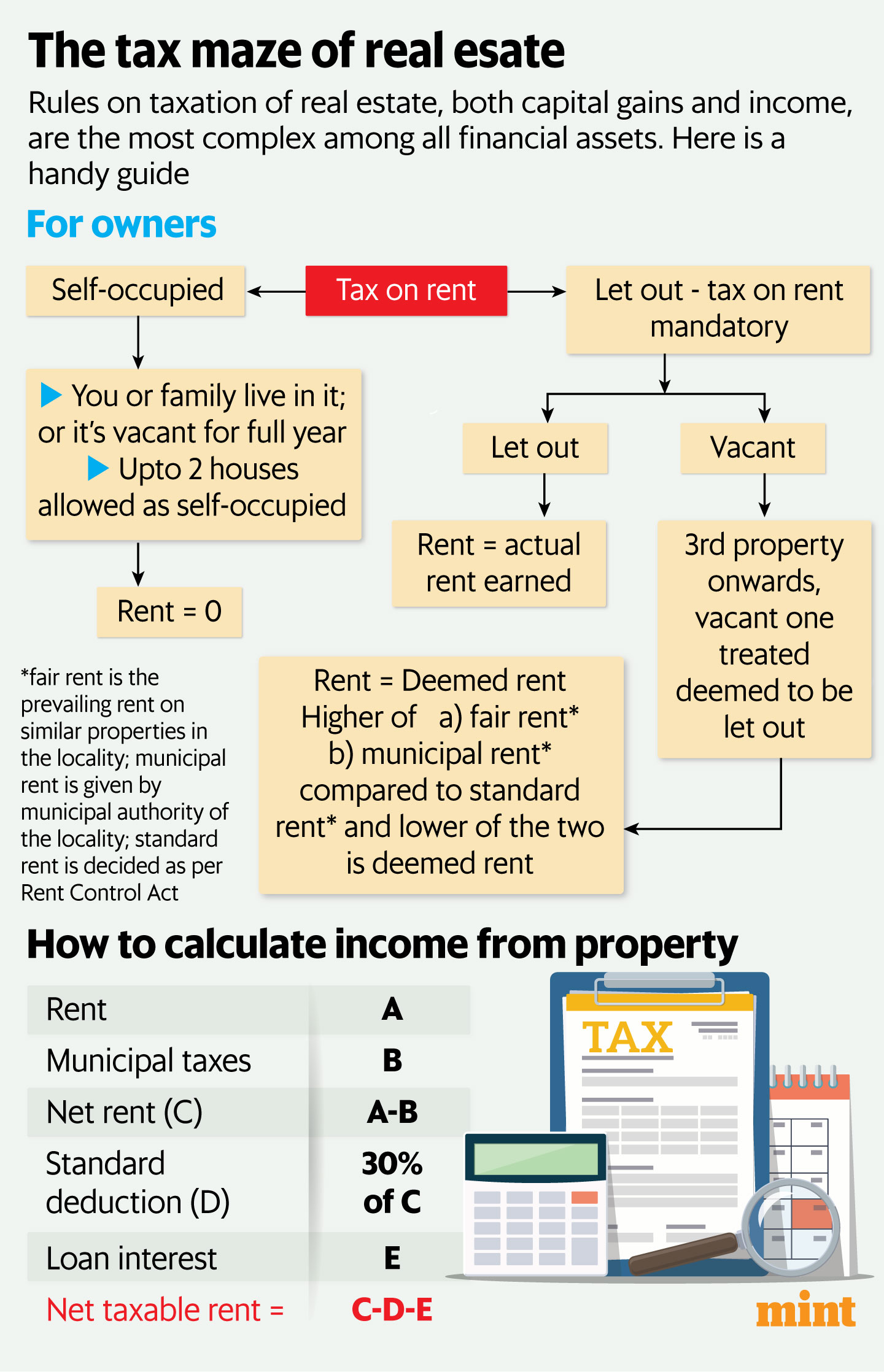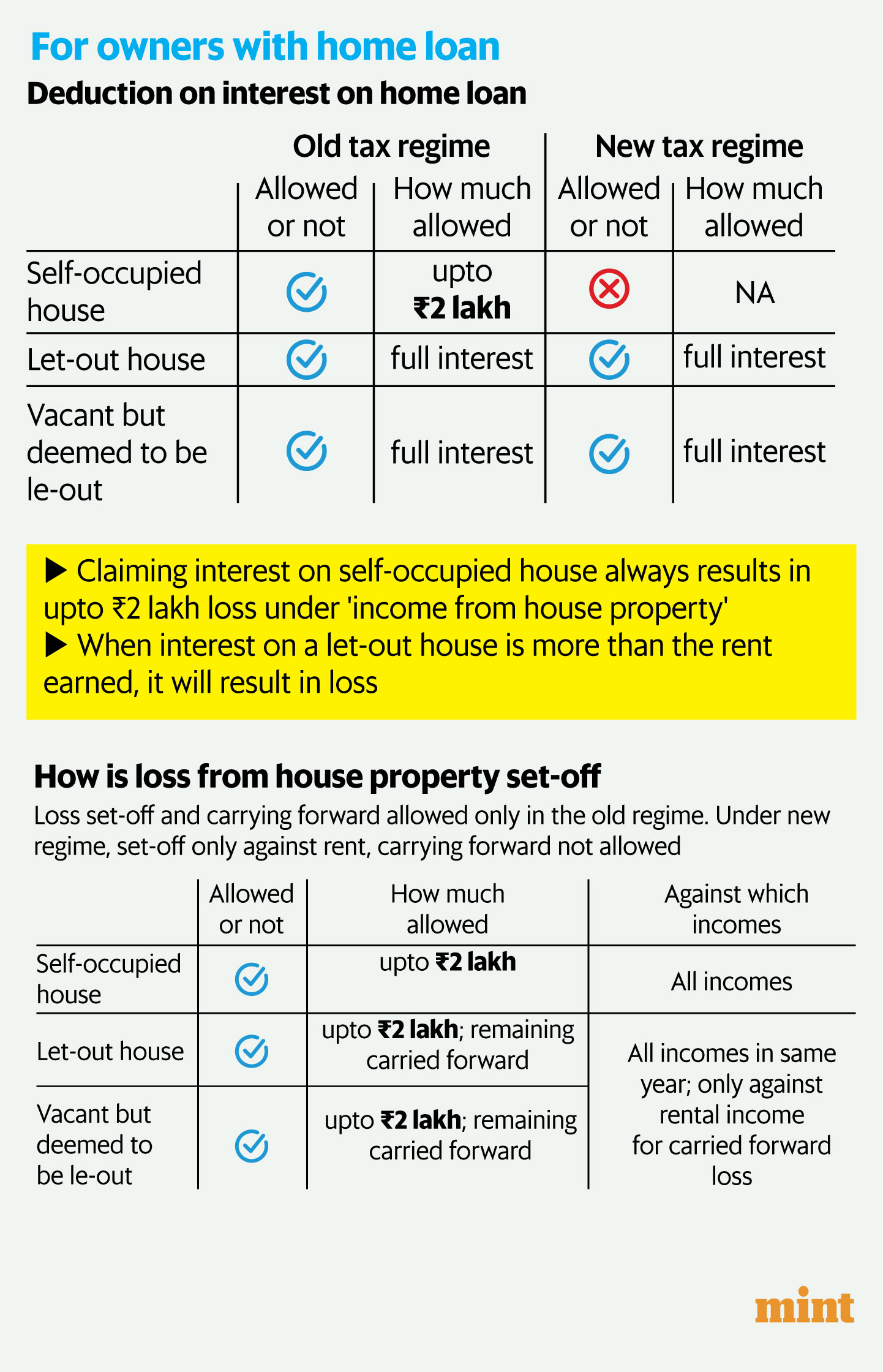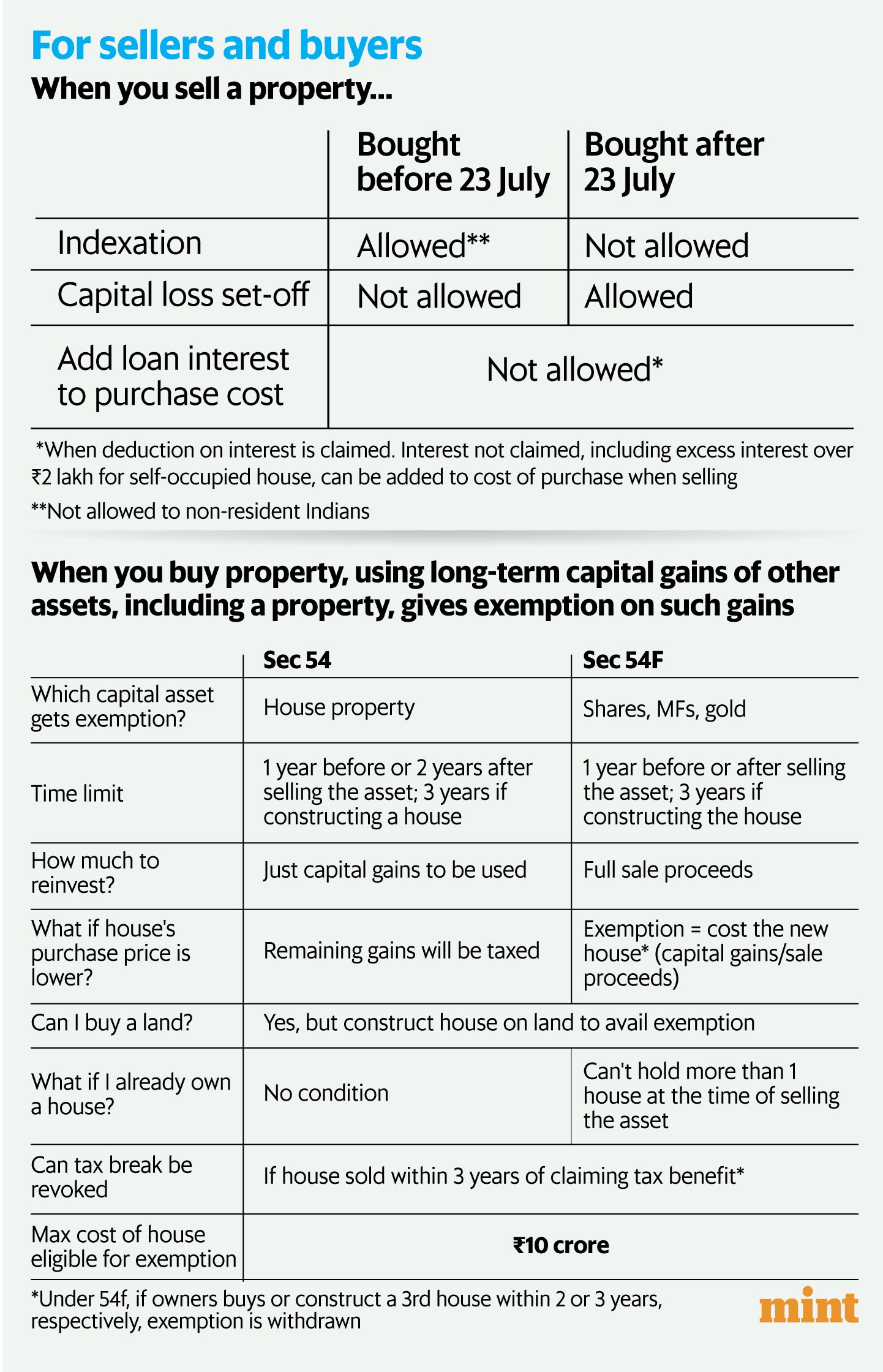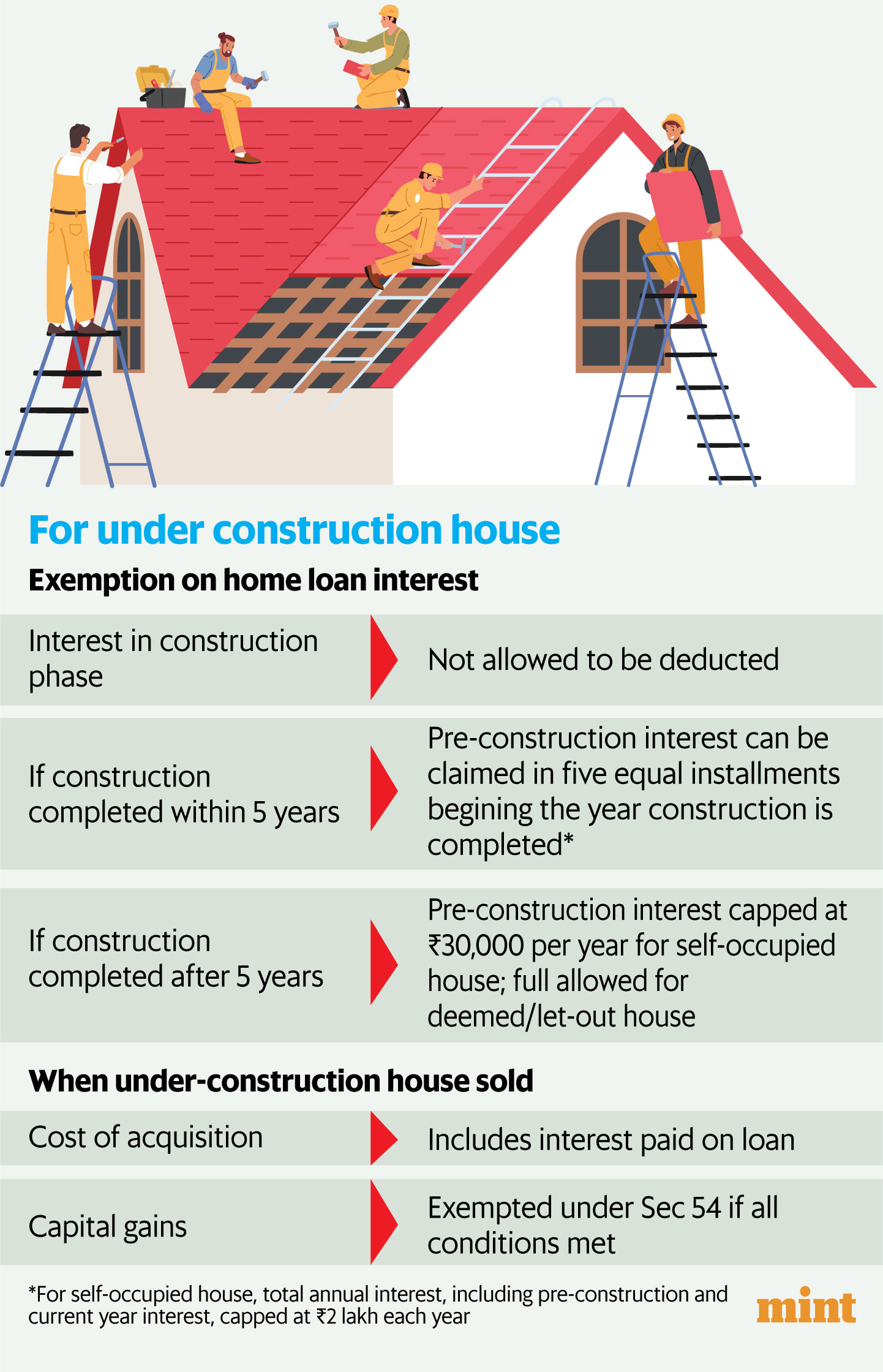There are layers upon layers, from rent to the time of selling to home loans. For instance, most of the rules applicable to a house or commercial property are not applicable to land. If a land owner earns rent, lease, or any other form of income on vacant land (without any construction), such income is not treated as rental income. It must be declared as income from other sources or profit from business.
There are separate rules for even under-construction properties (see chart).
Further, ownership is divided into three categories: self-occupied, let-out and deemed to be let-out. Now, rules on the taxation of rent, the extent of interest allowed to be deducted and the setting off of losses differ across the categories (see the chart).
The rules vary further depending on whether you opt for the new or old tax regime. For instance, if an owner has a home loan on the house they live in, each year, they will have a loss of up to ₹2 lakh under the ‘income from house property’ head. This is because, in the income tax return, one has to declare the rent of the self-occupied property as zero and claim the interest paid on the loan as a deduction. This results in a net loss from the house property equivalent to the interest paid. This loss is allowed to be set off against all incomes, including salary. But only in the old regime. So, homeowners living in their own houses will lose this benefit by opting for the new regime. In fact, under the new regime, the loss set-off is not allowed even for let-out and deemed to be let-out houses.
Mint has compiled a handy Q&A guide to help you navigate the real estate tax maze (see the chart). The guide and owners with a home loan.

View Full Image
I have two houses in the same city. I live in one house, while the second one is vacant. Will the second classify as self-occupied or deemed to be let out?
The first two houses that are either occupied by the owner or his family or are vacant qualify as self-occupied irrespective of which city they are in vis-a-vis the owner’s city of residence, according to Mayank Mohanka, founder, TaxAaram India and a partner at S.M. Mohanka & Associates. “This condition existed earlier, but now the rule is straightforward. The only condition is that it shouldn’t be rented out even partially during the year.”
I live on rent but own a house in the same city. Can I claim both HRA and deduction on home loan interest?
If your property was in a different city, you could straightway claim both HRA on the rent you’re paying and interest on your property, irrespective of whether it is occupied by your family, vacant or let out. However, when your property is in the same city, in most cases, claiming the HRA exemption won’t be allowed. If your office is far away from the house you own and you can justify that the reason to live on rent is to stay closer to the office and save on commuting, claiming HRA may be allowed.

View Full Image
The Union budget has disallowed the setting off of losses incurred in selling a property bought before 23 July. Does this also mean I can’t claim the ₹2 lakh loss made on a self-occupied house by claiming home loan interest?
Loss set-off is disallowed on capital loss incurred on selling a house. Whereas ₹2 lakh loss that arises on a self-occupied property by claiming interest on a home loan is loss under ‘income from house property’ head. Loss set-off disallowance is only applicable to the former.
“Loss from a house property and long-term capital loss are two separate heads. There are no changes in provisions relating to loss from house property,” said Prakash Hegde, a chartered accountant and principal consultant of direct taxation at Acer Tax & Corporate Services Llp.
I have carried forward loss under ‘house property’. If I opt for the new regime, can I set it off against other incomes?
Loss under ‘income from house property’ cannot be offset against any other income except rental income under the new regime. Loss that is not set off is not allowed to be carried forward to subsequent years either. This extends to carried forward loss from previous years as well, according to Parizad Sirwalla, partner and head, global mobility services, tax, KPMG India.
“If there is carried forward loss from let-out or deemed to be let-out properties from previous years, you can only set it off against the current year’s rental income. But, if the current year’s rent is in net loss, then the previous year’s loss can’t be set off or carried forward. It becomes a dead loss,” she said.

View Full Image
Take note that carried forward loss from a self-occupied house can’t be set off against rent either, as interest deduction on a self-occupied house is not allowed under the new regime.
To explain with an example, say you had a loss of ₹1 lakh from a let-out house in AY24 that wasn’t fully set off and carried forward. In AY25, if you opt for the new tax regime, you can’t set off this ₹1 lakh loss against any income but rent. If there’s no rent income, the ₹1 lakh loss becomes a dead loss. Further, while you can claim a deduction on interest on the same let-out house in AY25 also, if it results in loss, you can neither set it off nor carry it forward to AY26.
Mohanka said that once a carried forward loss becomes a dead loss, it can’t be set off in any subsequent years even if a salaried taxpayer switches back to the old regime.
In the same example, say you had ₹1 lakh loss again in AY25 that couldn’t be set off or carried forward. Now, if you opt back for the old regime next year in AY26, you can’t recoup the ₹1 lakh loss each from AY24 and AY25 as they couldn’t be carried forward.
I took a home loan on an under-construction house. Builder gave possession after seven years. How can I claim interest for the under-construction years?
Interest paid during the construction years is accumulated and can be claimed only after the construction is over. The total interest can be claimed in five equal instalments over five years after the construction is completed. However, on the self-occupied house, there are annual caps on the total interest, which includes accumulated interest and the current year’s interest, that can be claimed. This threshold further varies depending on whether construction is completed within five years or not.
If construction is completed within five years from the end of the fiscal year in which the loan was taken, up to ₹2 lakh can be claimed in one year. If construction is completed after five years, only ₹30,000 interest per year can be claimed as deduction.
Let-out and deemed to be let-out houses don’t attract these conditions. Full interest is deductible each year, irrespective of when the construction is completed. The only condition is that pre-construction interest is divided into five instalments.

View Full Image
Hegde said interest to be claimed each year will depend on whether the house is declared self-occupied or deemed/let out. Let’s understand with an example. Say, construction on a house is completed in 10 years, and the total pre-construction interest accumulated is ₹10 lakh. Each year ₹2 lakh pre-construction interest is to be claimed for five years. Now, say, in the first year, the house is occupied by the owner. Hence, only ₹30,000 interest can be claimed. But, in the second year, the house is put on rent. So, in this year, ₹2 lakh pre-construction interest, along with the current year’s interest, can be claimed. In the subsequent three years also, the extent of interest to be claimed will depend on the occupancy status of the house.
I’m selling an under-construction house. Can I add the interest paid on the home loan to the cost of acquisition?
With effect from FY24, interest claimed on a home loan has been disallowed to be added to the cost of acquisition or improvement of a property to avoid double deduction on interest. “There were cases where taxpayers claimed interest on home loan as deduction under the head ‘income from house property’ as well as the cost of acquisition/improvement of the property,” Hegde said. “The point to note is that this resulted in a double deduction, and hence this amendment was introduced. In an under-construction property, since deduction on interest is not allowed to be claimed, it can be added to the cost of acquisition if such property is being sold while it is still under construction,” he added.
